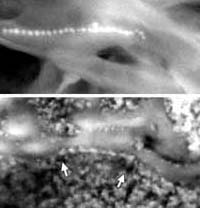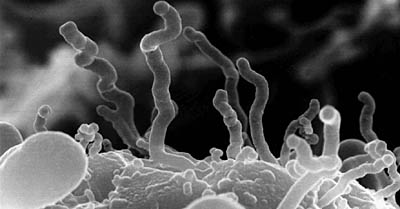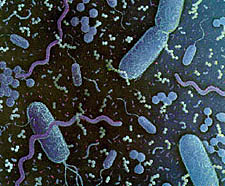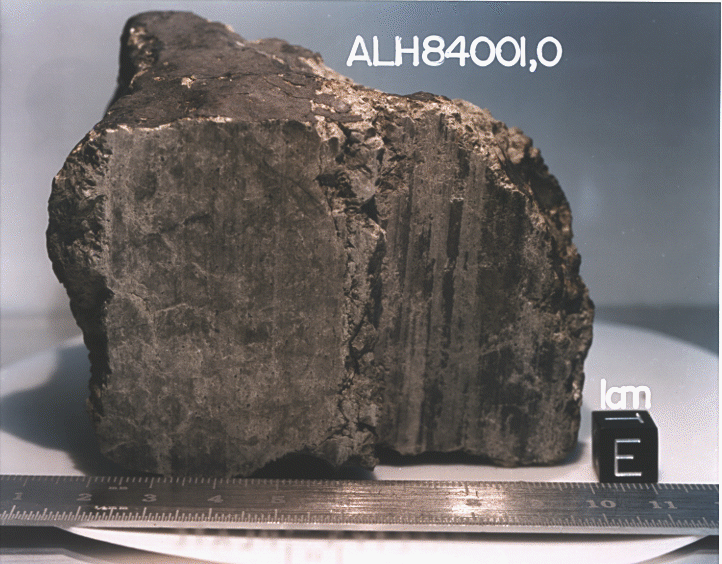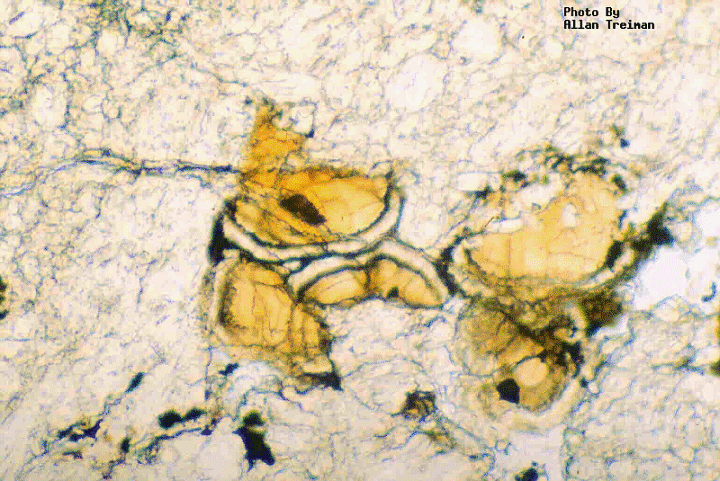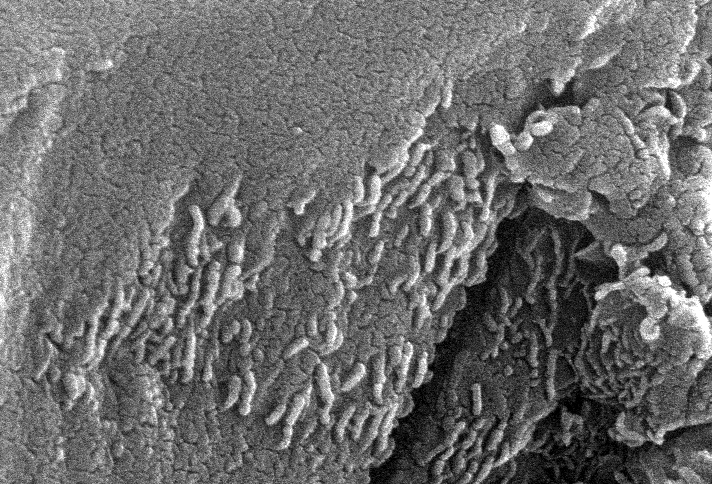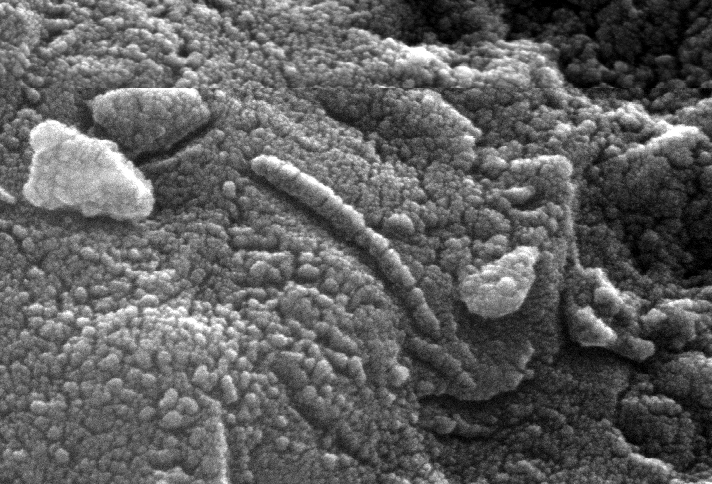|
Nanobacteria |
||||
|
.
28 February 2005 Excerpt While scientists debate whether nanobacteria are acutally biological in nature, researchers at NASA are calling for a major initiative to further investigate these tiny, self replicating agents. These same researchers are authors of a study published in Kidney International that says nanobacteria could be a potential cause of rapid kidney stone formation in astronauts on space missions. While scientists agree that these self-replicating, mineralizing agents exist, there is little agreement as to whether nanobacteria are actually alive, or indeed whether they carry anything resembling a DNA sequence. Nanobacteria were identified in the 1990s and have been found in the calcium phosphate centers of kidney stones. They have also been detected in other conditions, including Alzheimer's disease, heart disease, prostatitis, and some cancers. "The concept that nanobacteria are living organisms is still controversial because the research on their putative nucleic acid has not been completed yet," said lead researcher Neva Ciftcioglu. However, the group's research provides additional clues to understanding nanobacteria and its link to pathologic calcification-related diseases. In the published study, trials were conducted at NASA to observe nanobacteria in a bioreactor chamber which simulates conditions of space travel. In this microgravity environment, nanobacteria were found to multiply five times faster compared to normal gravity on Earth, supporting earlier discoveries that microbes have radically different behavior in weightless environments. Nanobacteria were also shown to possibly be an infectious risk for crew members living in close quarters. "Hopefully, eradication or treatment of these diseases will be possible in the near future. We need more research and support to solve this puzzle, but we feel that we are close," concluded Ciftcioglu. SOURCE: Science-A-Gogo |
||||
|
Nanobacteria: Astronauts at Highest Risk During Space Missions February 25, 2005
NASA researchers announce a potential cause of rapid kidney stone formation in astronauts on space travels. The authors of a study published in Kidney International call for a "Major Initiative" to investigate nanobacteria. Nanobacteria (NB), a novel self-replicating, mineralizing agent, has been identified by National Aeronautics and Space Administration (NASA) scientists as a potential culprit in kidney stone formation among astronauts. With the potential for future exploratory space missions to the moon and Mars, longer missions, and exposure to the elements of outer space, health is a major concern for astronauts. To further comprehend the implications of NB, trials were conducted at NASA to examine NB, in a bioreactor chamber which simulates conditions of space travel. In this microgravity environment, NB was found to multiply five times faster compared to normal gravity on Earth, supporting earlier discoveries that microbes have radically different behavior in weightless environments. NB is also shown to possibly be an infectious risk for crew members living in close quarters. "The concept that nanobacteria are living organisms is still controversial because the research on their putative nucleic acid has not been completed yet," states lead researcher Neva Ciftcioglu, Ph.D. However, the group's research provides additional clues to understanding NB and its link to pathologic calcification-related diseases. "Hopefully, eradication or treatment of these diseases will be possible in the near future. We need more research and support to solve this puzzle, but we feel that we are close," adds Ciftcioglu. Source: Blackwell Publishing Ltd. |
||||
|
Nanobacteria and Astronauts April 28, 2005 Kidney stones can be caused by many factors, including nanobacteria. The bacteria produce a coating of mineral deposits, forming hard, stone-like objects. In the zero-gravity of space, these bacteria grow five times as fast. |
||||
|
Chomping Away On Martian Nano-Nuggets .
Nanobacteria are not alive, but instead are the result of enzymes that break down organic material, according to a new study published in the journal Geology. Eight years ago, features resembling bacteria and measuring 20 to 100 nanometers across were discovered in the Martian meteorite ALH84001. NASA scientists interpreted these features to be the fossilized remnants of ancient life, but many scientists rejected that conclusion. A nanometer is one millionth of a millimeter. The period at the end of this sentence is about one million nanometers long. The tiniest bacteria measure about 200 nanometers in size, and many believe that life can't get much smaller than that. A committee formed under the auspices of the US National Academy of Sciences determined that, due to the size requirements of such vital elements as enzymes and genetic material, organisms smaller than 200 to 300 nanometers in diameter could not be self-sustaining and therefore could not be considered to be "life." Others contend that life can be that small, and as proof they claim to have grown nanobacteria in the laboratory. In addition to the nanobacteria in the Martian meteorite, spheroidal features measuring 50 to 200 nanometers have been found in sedimentary rocks on Earth. Some claim that these spheroids are the fossilized remains of once living nanobacteria. The new study, conducted by Joergen Schieber of Indiana University in Bloomington and Howard Arnott of the University of Texas at Arlington, suggests an alternative explanation for nanometer-sized features. The scientists report that protein balls measuring 40 to 120 nanometers across are produced when bacterial enzymes cause organic material to decay. Schieber and Arnott dipped tiny pieces of bean, squid and beef into the muck from a pond, to ensure that the samples became coated with the full spectrum of naturally occurring decay bacteria. The samples were then buried in clay to simulate the burial of organic matter in sedimentary rock. Over the next two weeks, the researchers found the tissue samples experienced "explosive" bacterial growth, and balls measuring 40 to 120 nanometers in size were widespread. The scientists say that these "nannoballs" compare well with published examples of nanobacteria. "Because gradual decay of tissues always led to formation of nannoballs, we surmised that the latter resulted when microbial enzymes interacted with the buried samples," the scientists write. The scientists also exposed tissues to various purified protein-degrading enzymes in separate experiments, and this confirmed that such enzymes were responsible for the nannoballs. The enzymes snip the larger tissue elements like cell walls and muscle fibers into nanometer-sized units. Once snipped, the tissues contract into balls due to elastic forces. This enzymatic breakdown of organic matter may act as an aid to decomposition, the scientists suggest, reducing material to bite-sized nuggets for bacteria to ingest. "Bacteria are osmotrophs and can only take in dissolved molecules liberated by exoenzymes utilized outside of the cell," write the scientists. "Seeing no subunits smaller than our nannoballs, we assume that in the subsequent degradation step, the nannoballs are broken down by further enzyme action into soluble molecules that can be ingested by bacteria." Nannoballs are not always consumed by bacteria, say the scientists, because under certain conditions the tissues can become mineralized. This mineralization preserves the nannoballs, turning them into fossils in just a few weeks. Although the nannoballs are not fossilized life forms, they can act as "biomarker" evidence for bacterial life. "Most if not all alleged nannobacterial structures in sedimentary rocks are probably by-products of bacterial degradation of organic matter and not evidence for minute life forms called nannobacteria," the scientists conclude. "Nonetheless, mineralized nannoballs may indicate bacterial enzyme action on organic tissues and serve as a visual proxy for microbial activity." Kathie Thomas-Keprta, an astrobiologist with Lockheed Martin at NASA's Johnson Space Center, has studied the magnetite and carbonate mineralogy of the martian meteorite ALH84001. She says that if microbes on Earth produce nannoballs as they degrade certain minerals, as they do with the tissues in this new study, then the nannoball-like texture observed on the surface of carbonate globules in ALH84001 may be a product of such microbial etching. However, she says it's still possible that the features in ALH84001 are the fossilized remains of microbial life. Part of the problem with the debate over the size constraints of life, says Thomas-Keprta, is that microbes can shrink substantially after death. "The size of a viable organism may be vastly different from the size of that organism when fossilized or mineralized," she states. "We do not understand how the size of organisms changes with fossilization or mineralization, nor do we know if particular categories of organisms can be better preserved than others." While the physical shape and size, or morphology, of a structure is not enough to determine whether it was once a living microorganism, certain surface textures might be evidence of past biological activity. A granular surface texture composed of nannoballs, in conjunction with other biomarkers, may provide further evidence that certain morphological features were once microbial life. SOURCE: Mars Daily Related Links: |
||||
|
How Small Can Life Be? Jul 09, 2001
Some scientists believe that life can be very small
indeed. Called nanobes, nanobacteria, or nano-organisms, these miniscule
structures borrow their name from their unit of measurement, the nanometer.
A nanometer is one billionth of a meter. That's about the length of 10
hydrogen atoms laid out side by side. The period at the end of this sentence
is approximately one million nanometers in diameter.
Credit: Conneticut Food Protection Program While the tiniest bacteria measure 200 nanometers across, nanobes are even smaller. They can range anywhere from 20 to 150 nanometers long. What first caught the attention of some scientists was the way nanobes are shaped. They look remarkably like bacteria, forming spheres, chains of beads, filaments, or bean- or sausage-like shapes. Nanobes seem to share other important qualities with bacteria. For one thing, nanobes are often found grouped together in clusters. Also, some scientists claim they can grow colonies of nanobes by culturing them in the lab. The nanobes seem to spontaneously grow on metal, glass, plastic or organic surfaces which are left in water or exposed to oxygen for a few days or weeks. One scientist who firmly believes that nanobes are alive is Robert Folk of the University of Texas at Austin. In 1990, Folk discovered bacteria-like structures about 100 nanometers in size in Italian hot-spring deposits. He went public about his findings at a Geological Society of America meeting in 1992. "NASA scientist Chris Romanek heard my talk, and decided to look for nanobes in the Martian meteorite," says Folk. "He found them, and the rest is History - or Scandal, if you prefer." SOURCE: Astrobiology Magazine |
||||
|
On the Question of the Mars Meteorite .
What is ALH 84001, the Mars meteorite with the possible fossils? LH 84001 is a meteorite, a rock that fell to Earth from space. It was found in December 1984 in Antarctica by a U.S. meteorite-hunting expedition. When it was found, ALH 84001 weighed about 4 and 3/4 pounds (1.93 kilograms). It was shaped like a rounded brick or a large potato, about 6 inches long by 4 inches by 3 inches, and was partly covered with black glass (like it was dipped in tar). The glass, called fusion crust, forms on all meteorites when they burn through the Earth’s atmosphere. ALH 84001 looked green inside, which really excited the expedition. But back at civilization, ALH 84001 looks much grayer inside than green. ALH 84001 formed originally from molten lava, about 4.5 billion years ago, which is called its igneous age, possibly from an ancient martian volcano. To a geologist, ALH 84001 is an igneous rock, similar to many that crystallized from lava inside the Earth. ALH 84001 is also similar to an important group of igneous meteorites (the diogenites), and was classified as one of them until 1994 when its martian origin recognized by Mittlefehldt (1994). - SOURCE: LPI How can you possibly claim that ALH 84001 came from Mars? It’s nearly certain that ALH 84001 is from Mars, even though people have never been to Mars and no rocks have ever been collected on Mars. In fact, there are 11 other meteorites, called the SNCs, that are also almost certain to be from Mars. The strongest evidence for their martian origin is that they, including ALH 84001, contain traces of gas that is just like the martian atmosphere. We know the composition of the martian atmosphere, because the Viking Lander spacecraft analyzed it, on Mars, in 1976. The martian atmosphere is really different from the Earth’s atmosphere, or Venus’, or any other source of gas that’s ever been found. - SOURCE: LPI How could ALH84001 get from Mars to Earth? To get off Mars, ALH84001 must have left its surface going faster than Mars’ escape velocity, about 5 kilometers per second (about 11,000 miles per hour). The only known natural process that can get rocks moving so fast is meteorite impact--volcanoes can’t throw rocks fast enough. If a large enough meteorite or asteroid hit Mars, some rocks nearby on Mars’ surface would be blasted up faster than the escape velocity and could leave Mars completely. The best estimates are that an asteroid bigger than about 1/2-2 kilometers could launch rocks like ALH 84001 off Mars and into space. After it left Mars, ALH 84001 orbited the Sun on its own, like a small asteroid. It started out with an orbit nearly like Mars’. But its orbit changed each time it passed close to Mars or collided with an asteroid. Also, gravity from the planets (especially from enormous Jupiter) slowly nudged ALH 84001 farther and farther from Mars. By chance, the orbit of ALH 84001 changed enough so that it came near the Earth's orbit. 13,000 years ago, the Earth and ALH 84001 collided. - SOURCE: LPI When did ALH 84001 leave Mars? ALH 84001 was probably blasted off Mars about 16 million years ago; it could have been longer ago, but not much more recently. This age is actually how long ALH 84001 was in space, exposed to cosmic rays, as it traveled between Mars and the Earth. ALH 84001 might have been in space longer if were shielded from cosmic rays, for instance if it were from the inside of a larger boulder. In this case, the boulder would have broken up 16 million years ago, exposing ALH 84001 to cosmic rays. - SOURCE: LPI When did ALH 84001 land on the Earth? The best estimate is that ALH 84001 landed on Earth, in Antarctica, about 13,000 years ago. - SOURCE: LPI How and when was ALH 84001 found? ALH 84001 was found in Antarctica during the 1984-1985 Antarctic summer. It was found by a team of meteorite hunters from the ANSMET program, which is sponsored by the Polar Programs Office of the U.S. National Science Foundation. ANSMET stands for ANtarctic Search for METeorites, and has been funded since 1977 by the NSF. In that time, ANSMET meteorite hunters have found more than 7000 meteorites, almost triple the number known from outside Antarctica. The Antarctic Meteorite Location and Mapping Project (AMLAMP) provides locations, maps, and databases of meteorite finds. - SOURCE: LPI
The possible evidence of life in ALH 84001 was all found in and around carbonate mineral globules. In this microscope view (~0.55 mm across), the cores of the globules are orange-brown, fading outward to colorless, and are surrounded by black and clear bands. Other minerals in ALH 84001, which surround the globules, include orthopyroxene and plagioclase. Both are colorless in this view. . SOURCE: LPI |
||||
|
Fossil Life in ALH 84001? "These pages are an explanation of the Science paper of Dr. David McKay and his co-workers, where they give evidence that martian bacteria may have lived in the martian meteorite ALH 84001. I’ve tried to organize and review their evidence that ALH 84001 contains fossils and traces of ancient martian life, and also tried to outline some counter-evidence and some likely questions about the evidence. My intention is to present the work of McKay and co-authors even-handedly and nonjudgmentally." - Allan H. Treiman, Lunar and Planetary Institute. In their paper in Science magazine, Dr. David McKay and his co-workers give evidence that martian bacteria may have lived in the martian meteorite ALH 84001. To set the stage, McKay and his co-workers review the evidence that ALH 84001 is from Mars, that it was infiltrated by liquid water while it was on Mars, and that the water infiltrated very long ago. Then, McKay and co-authors describe three sets of observations about ALH 84001 that all could have been produced by martian bacteria. But, as they say, “None of these observations is in itself conclusive for the existence of past life. Although there are alternative explanations for each of these phenomena taken individually, when they are considered collectively, particularly in view of their spatial association, we conclude that they are evidence for primitive life on Mars.” McKay and his co-workers DO NOT claim that they found live martian bacteria; they only claim to have found evidence of dead, fossil bacteria and chemical traces that might have come from bacteria. They have no evidence for martian organisms more complicated than bacteria--no eucaryotes (cells with nuclei), no multicelled creatures, no plants, no animals, and no “little green men”. SOURCE and Collection of Papers Excerpts; Shapes that Resemble Bacteria
It turns out that many Earth bacteria have essentially the same sizes and shapes as do the structures that McKay and co-workers found in ALH 84001, as shown in their Fig. 6. These minute Earth creatures, the “nanobacteria,” were first discovered living inside rock, and have since then been found inside rocks from many different places and environments. They have even been found growing happily in volcanic rocks (similar to ALH 84001) from five kilometers beneath the surface of eastern Washington state... |
||||
|
Scientists Find Evidence of Ancient Microbial Life on Mars Moffett Field - Feb. 26, 2001 An international team of researchers has discovered compelling evidence that the magnetite crystals in the martian meteorite ALH84001 are of biological origin. The researchers found that the magnetite crystals embedded in the meteorite are arranged in long chains, which they say could have been formed only by once-living organisms. Their results are reported in the Feb. 27 Proceedings of the National Academy of Sciences. "The chains we discovered are of biological origin," said Dr. Imre Friedmann, an NRC senior research fellow at NASA's Ames Research Center in California's Silicon Valley and leader of the research team. "Such a chain of magnets outside an organism would immediately collapse into a clump due to magnetic forces," he said. The chains were formed inside organic material whose structure held the crystals together. "The end result looks somewhat like a string of pearls," Friedmann noted. Each magnetite crystal in the chain is a tiny magnet, approximately one-millionth of an inch in diameter. Magnetite is an iron oxide, similar to iron rust. The chains may have served as 'compasses' for the host magnetotactic bacteria, so named because they navigate with the help of the magnetic crystal chains inside their bodies. The chains were preserved in the meteorite long after the bacteria themselves decayed. The researchers say the magnetite chains probably were flushed into microscopic cracks inside the martian rock after it was shattered by an asteroid impact approximately 3.9 billion years ago. This cataclysmic event on Mars' surface also may have killed the bacteria. The same, or a later, asteroid impact ejected the rock, now a meteorite, into space. Another NASA research group, led by Kathie Thomas-Keprta of NASA's Johnson Space Center, report in the same issue of PNAS that the magnetite crystals inside the meteorite are similar to those formed by 'modern' magnetotactic bacteria now living on Earth. The team studied only single crystals, however, not the elusive chain-like structures. Friedmann's team discovered the crystal chains using a technique that enabled them to 'see' the tiny chains inside the meteorite without destroying them. Besides the chain-like formation, the team discovered that individual crystals are of similar size and shape, do not touch each other and that the chains themselves are flexible, further evidence of biological origin. "Until now, studying life has been like trying to draw a curve using only one data point -- life on Earth," said Friedmann. "Now we have two data points to draw life's curve." The next step is to find the remains of the bacteria themselves, he said. The fact that a small (about 4-pound) meteorite from a planet contains large numbers of bacteria suggests that such bacteria were widespread on the surface of Mars, the researchers say. A stone of similar size from Earth would contain many bacteria. In addition, since magnetotactic bacteria require low levels of oxygen, this finding indicates that photosynthetic organisms, the source of oxygen in the atmosphere, must have been present and active on Mars 3.9 billion years ago. "Finding evidence of life on Mars is one of the central problems in astrobiology research today," said Dr. Michael Meyer, head of NASA's astrobiology program, which funded the research. In addition to his fellowship at NASA Ames, Friedmann, who is best known for discovering microorganisms living inside desert rocks, is professor emeritus of biological science at Florida State University. Members of the research team include Dr. Jacek Wierzchos (University of Lleida, Spain), Dr. Carmen Ascaso (CSIC, Madrid, Spain), and Dr. Michael Winkelhofer (University of Munich, Germany). The meteorite ALH84001 was found in the Allen Hills region of Antarctica in 1984 by researchers supported by the National Science Foundation's Antarctic Search for Meteorites Program, a joint effort by the NSF, the Smithsonian Institution and NASA. Case Western Reserve University in Cleveland manages the program. SOURCE: Mars Daily |
||||
| FAIR USE NOTICE: This page contains copyrighted material the use of which has not been specifically authorized by the copyright owner. Pegasus Research Consortium distributes this material without profit to those who have expressed a prior interest in receiving the included information for research and educational purposes. We believe this constitutes a fair use of any such copyrighted material as provided for in 17 U.S.C § 107. If you wish to use copyrighted material from this site for purposes of your own that go beyond fair use, you must obtain permission from the copyright owner. | ||||
|
|

